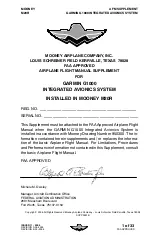
Rev 1 Mar/2000
KMD 150 Pilot's Guide
151
APPENDIX 4 - DIFFERENTIAL FUNCTIONS
Your KMD 150 unit has been designed to enable it to make use of
Differential GPS (DGPS) correction.
WHAT IS DGPS?
GPS on its own is, as we have seen in
rate system for all general navigation purposes. It is not, however, per-
fect. The most significant source of error in GPS positional calculations
is the deliberate downgrading of accuracy known as Selective Availability
(SA) described in
Satellite clocks, although superbly accu-
rate, also have tiny errors that can affect the accuracy of a fix. So also
does any slight drift from a satellite's predicted orbit. The signals from
satellites have to pass through the earth's atmosphere and, although
radio signals travel at the speed of light, this is only a constant through a
vacuum. Things like water vapor in the troposphere and charged parti-
cles in the ionosphere do slow down satellite signals and cause slight
delays that translate into errors in position. And finally it must be admitted
that GPS receivers are not perfect either. These can themselves induce
further small positional errors, mainly as a result of receiver noise or
clock inaccuracy.
DGPS can virtually cancel out all of the errors due to SA, to orbital errors
and to satellite clock inaccuracy. It also greatly reduces any error caused
by the atmospheric delay to radio signals. What DGPS cannot correct
for are only the inaccuracies due to the GPS receiver itself and possible
"multi-path" errors which (like "ghosting" on a TV) are due to secondary
signals being received after reflection off local obstructions. The net
result of all this is that while standard GPS can experience errors of
between 15 and 100 meters (depending largely on whether SA is active
or not) DGPS is already capable of accuracy's down to 1.3 meters hori-
zontally and 2.0 meters vertically.
HOW DOES DGPS WORK?
Any two GPS receivers within a few hundred miles of each other will
receive satellite signals that have been affected by virtually the same
errors as each other. The signals emanate from the same group of
satellites, travel through the same portion of the earth's atmosphere and
so will be subjected to the same delays. Thus, all the errors (except
those due to multi-pathing and to the receivers themselves) will be
common to both. So if one of these receivers is located at a fixed point
that has been extremely, precisely surveyed it can be used as a refer-
ence. Instead of using the signals to calculate its position, since it
already knows its position it can calculate the errors in the incoming sig-
nals.
Differential Functions
KMD 150 PG 5/12/00 12:58 PM Page 151


































